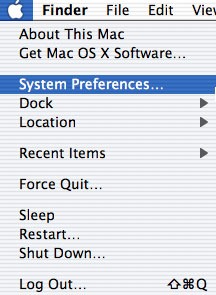Note: Mac key convention: ' Ctrl ' is used for 'Control', ' Apple ' is used for 'Command' and ' Alt ' is used for the 'Option' key.
Note: For keyboard access make sure ' Full keyboard access ' is turned on - you can turn it on or off; by pressing ' Ctrl ' + ' F1 ' at any time.
Step 1
- Make sure you are in ' Finder ' - press ' Apple ' + ' Tab ' if necessary to cycle through open applications until you return to ' Finder '.
- Click on the 'Apple ' menu or press ' Ctrl ' + ' F2 '.
- Click on ' System Preferences... ' as shown in Fig 1 or press the down arrow key to highlight it and then press ' Enter '.

Fig 1
Step 2
- Click on the 'Universal Access ' icon or press ' Tab ' repeatedly (you might need to press ' Ctrl ' + ' F7 ' first) to cycle through the icons until the ' Universal Access ' icon is highlighted with a blue border and then press the ' Spacebar '. Fig 2

Fig 2
- Click on the ' Keyboard ' tab or press ' Ctrl ' + ' F7 ' (once or twice) to highlight one of the four tabs for example ' Seeing ' and then press the left or right arrow key to select the ' Keyboard ' tab.

Fig 3
- Click to select Sticky Keys 'On' button as or press ' Tab ' to highlight the ' Sticky Keys Off ‘button and press the left arrow button to switch ' Sticky Keys On '. Fig 3
- Tab to or click to select ‘Press the Shift key five times to turn Sticky Keys on or off ’.
Note: If this does not work it could be because your computer settings cannot be changed due to local IT policies - contact your local IT support for further help.
Need some more help?
Call our helpline 0300 180 0028 or email enquiries@abilitynet.org.uk
Need free IT Support at Home?
If you are older or disabled and need IT support at home, you can book a free home visit.